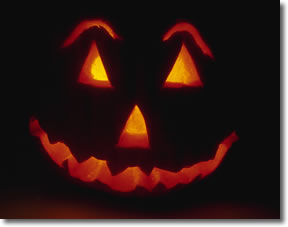Welcome, All Hallow´s Eve
The Christian Roots of Halloween
 I’m excited about Halloween this weekend. In addition to devouring all the Snickers bars a girl could ask for, I’m planning to welcome the holiday as what it was intended to be: a night of holiness, a remembrance of the dead, a chance to take stock of the gift of life and the triumph of good over evil. All that is a lot to pack into a night we traditionally associate with harmless children’s amusements at best and darker themes at worst, so let me explain myself by way of a short history lesson.
I’m excited about Halloween this weekend. In addition to devouring all the Snickers bars a girl could ask for, I’m planning to welcome the holiday as what it was intended to be: a night of holiness, a remembrance of the dead, a chance to take stock of the gift of life and the triumph of good over evil. All that is a lot to pack into a night we traditionally associate with harmless children’s amusements at best and darker themes at worst, so let me explain myself by way of a short history lesson.
Christians are often surprised to learn that Halloween, or All Hallow’s Eve in traditional church parlance, has a strong and rightful place in the liturgical calendar as one of the holiest nights of the year. As the night before All Saints’ Day, Halloween is the celebration that precedes a liturgical thinning of the veil, a symbolic dissolution of the boundaries that separate the living and the dead. On All Saints’ Day, traditionally, Christians would remember all those early martyrs who died for the faith but who weren’t quite A-list enough to nab their very own feast days as individual saints. The holy day used to be held in the spring—which is when Eastern Christians still observe it—but was moved to November 1 in the West more than a thousand years ago to override the influence of pagan harvest celebrations.
So for well over a millennium, All Saints’ Day has been inextricably intertwined with fall festivals, which is why Halloween is such a confusing hodgepodge of the sacred and the secular, the earth and what lies beyond. We have pumpkins and gourds alongside zombies and ghouls; we recognize the dead with ghosts and candles but simultaneously celebrate the living earth with cornucopia, wreaths, and flowers.
It’s understandable that Christians would be anxious about a holiday that seems fixated on death, but we need to realize that many of Halloween’s beloved customs arose as Christian attempts to fight evil, not to invite it in. For example, the idea of dressing up in costumes on Halloween came about because the Church taught that in the liminal time before and during All Saints’ Day, spirits of the dead roamed freely and could disturb the living. Rather than be tormented by these spirits, especially evil ones with unfinished business, people would dress as someone (or something) else to confuse the dead.
Halloween costumes arose as a bait-and-switch, in much the same way that wedding customs stipulate to this day that there should be “decoys” of the bride and groom to throw malevolent spirits off their game. Heroic groomsmen and bridesmaids have been on hand since medieval times to distract evil spirits, who apparently have a predilection for anyone wearing Seafoam Green.
Christian and pagan elements merged freely in the Middle Ages, and continue to do so today. Have you ever said “bless you” to someone when they sneezed? You thought you were just being polite, but your ancestors said it to ward off evil spirits: a sneeze was believed to open up the body’s orifices to evil influences. In the same vein, our ancestors posted gargoyles near their drainpipes and stately lions at their gates—all the better to intimidate the wicked spirits who sought to insinuate themselves into homes and churches.
It’s safe to say that when most of us take our kids out trick-or-treating, we won’t be thinking of spirits that may or may not be marauding around us. In a way, that’s a shame. At its best, Halloween is more than an entertaining opportunity for children to try on different personalities through dress-up (though that is a hugely important part of growing up). It’s more, even, than a cultural open house where people actually communicate and share with their neighbors—all too rare in our culture today.
Halloween at its best has the chance to be truly hallowed, or holy, a time to think about death while also fully engaging the world of the living: our children, having a terrific time; our beautiful earth, giving up the fruits of the harvest for another year and digging in for winter. This is the kind of Halloween that many Catholics recognized until 1970, when All Saints’ Day was downgraded from a fast day.
What will Halloween mean for you? I’ll tell you a little of what it will mean for me: that in the midst of the pure fun of children’s laughter and caramel apples, I will be thinking a little more about death and feeling a little more grateful about life. I will be lighting candles for my grandmothers, who have passed on, and feeling thankful for their spirits. And the next day, while nursing a chocolate hangover, I will take the time to think about all the saints who have gone before.
Copyright © 2008 Jana Riess